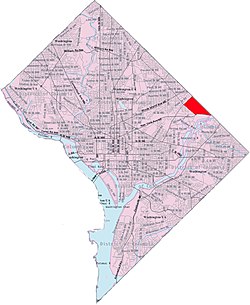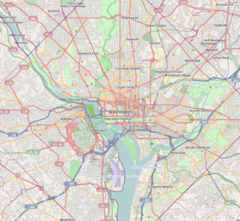Fort Lincoln, Washington, D.C.
| Fort Lincoln | |
|---|---|
| Neighborhood of Washington, D.C. | |
 Fort Lincoln within the District of Columbia |
|
| Country | United States |
| District | Washington, D.C. |
| Ward | Ward 5 |
| Government | |
| • Councilmember | Kenyan McDuffie |
| Area | |
| • Total | 0.47 sq mi (1.2 km2) |
| Fort Lincoln | |
|---|---|

Brigade headquarters at Fort Lincoln, circa 1861-1869
|
|
| Location within Washington, D.C. | |
| Location | Washington, D.C. |
| Coordinates | 38°55′26″N 76°57′22″W / 38.924°N 76.956°WCoordinates: 38°55′26″N 76°57′22″W / 38.924°N 76.956°W |
| Website | tclf |
Fort Lincoln is a neighborhood located in northeastern Washington, D.C. It is bounded by Bladensburg Road to the northwest, Eastern Avenue to the northeast, New York Avenue NE to the south, and South Dakota Avenue NE to the southwest. The town of Colmar Manor, Maryland, is across Eastern Avenue from the Fort Lincoln neighborhood, as is the Fort Lincoln Cemetery.
The name Fort Lincoln was originally used for a Civil War Fort in adjacent Prince George's County, Maryland, across the D.C. line from the Washington neighborhood bearing its name.
This northeast Washington neighborhood is home to the Fort Lincoln "New Town" development constructed in the 1960s and 1970s. This neighborhood is currently the home of Cathy Lanier, Chief of the D.C. Metropolitan Police. In 2011 another 42 acres of the wetland forest park was sold to make a shopping center.
The Fort Lincoln area includes a Civil War-era fort, Fort Lincoln, constructed in 1861 for the defense of Washington. The fort is now part of Fort Lincoln Cemetery, and can be visited.
Fort Lincoln is a Civil War earthwork in the Fort Lincoln neighborhood. It was constructed in 1861 for the defense of Washington. The fort was built along the District line in adjacent Prince George's County, Maryland, directly along the line of the Baltimore and Ohio Railroad between Baltimore, Maryland, and Washington.
...
Wikipedia

